Exploring ‘Ico’: Attachment, Isolation and the Player
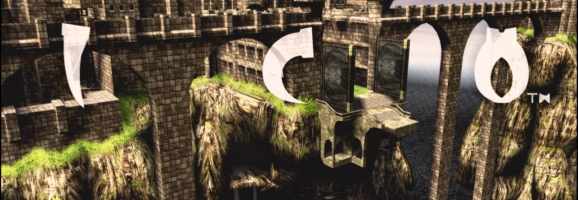
Compared to other mediums, videogames have gone relatively untouched when it comes to in-depth analysis. This is an unfortunate oversight, as they offer so much more to the user than film, literature or visual art. While those mediums are innately passive and require extra effort from the audience for engagement, videogames are intrinsically interactive, forcing the user to engage with the content. An understanding of how game mechanics can influence player emotion and thought is long overdue, as we are now seeing a rise in independent game developers producing works that challenge and subvert the expectations and perceived rules of these mechanics.
Though not subversive, Ico, a 2002 game designed and directed by Fumito Ueda for the Playstation 2, offers great insight into how interactivity can influence player emotion, creating a masterful experience of loneliness and isolation. It is a minimalist game in which the player controls the titular young boy, a cursed, horned outcast sent as a sacrifice to an immense castle on an island off the coast of an unknown mainland. Ico escapes his captivity and begins to explore the castle, finding a young girl named Yorda. The game’s objective is to escape the castle with Ico’s newfound companion.
One quick technical note: one of the challenges in discussing games is that the player-character is simultaneously the player, and a character of the game developer’s design. Reference to the character of Ico is therefore interchangeable with the player. I will continue to refer to Ico the character, however, because there are some cases where I will wish to draw attention to effects on the player separately to the character. Just be aware that when I say “Ico’s newfound companion,” I could just as easily be saying, “Your newfound companion.”
The Boy with Horns
Ico begins its treatise of isolation with the bare-bones plot it allows the player to glimpse. Ico – and therefore the player – is an outcast, sent away from a distant, barely visible mainland as a sacrifice to a mysterious dark figure, The Queen. The entire game has an air of hopelessness about it. That great landmass in the distance is simultaneously the goal and a symbol of Ico’s solitude. He was sent from that land because he did not belong, and now he struggles to return.
The reason for his isolation is a physical ailment – the presence of horns: a symbol of some kind of curse. Typically horns represent the devil or some other great evil, but Ico is a picture of innocence from his bright pastel-orange shirt to his childish, unbroken voice. The isolation appears undeserved, and this is why Ico works as an avatar for the player.
The Castle
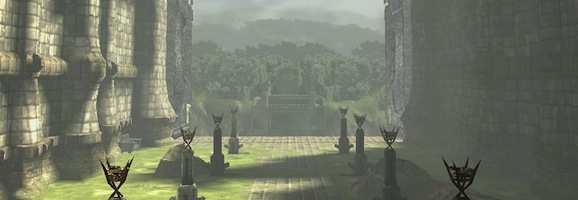
Your first moments of direct control in Ico occur in an enormous, high-ceilinged hall filled with stone prisons. You are completely alone. You receive no guidance. Unlike most games, Ico neglects to include in-game messages for the player and also lacks a heads-up display (HUD – an indication of health, equipment etc). Without any communication or guidance from developer to player, the player is completely immersed in Ico’s world, and in being Ico. More importantly, the sense of isolation is compounded by the fact that there is no meta-game communication. The player, like Ico, is alone in this world.
With no in-game prompts, progress relies on visual iconography to communicate game mechanics. Actions are intuitive – a bomb looks like a bomb and can be used just as one would expect a bomb to be used. Structures that can be bombed are indicated not by gamey arrows or lights but by fragile-looking structures in the game world. Hints don’t come as on-screen words but as Yorda, Ico’s companion for much of the game, pointing at important objects within the space. It is essential for as much distance to be drawn between the game mechanics and the player as possible because game mechanics imply a human creator or rule-maker, the game designer, and that presence would destroy the game’s central theme of isolation.
But Ico is a game, and cannot escape some of the trappings of game design. Though it is hidden well, Ico has incredibly gamey objectives – light the beacons and open the gate to escape. The puzzles are exactly that – puzzles, existing in a vacuum as though waiting to be solved. This is almost the only point on which Ico’s thematic strength falters – the presence of the game designer is seen simply through the fact that there is a workable solution for each room’s puzzle. The castle’s collapsing structures have fallen just right to allow you to jump across that gap. The switch to the bridge is accessible if you climb this particular section of wall. The sword needed to progress just happens to be in the adjoining room. The fact is, Ico is a game, and it is impossible to completely negate the influence of the designer. At a glance, however, these solutions appear completely natural, and it is only with further consideration that they seem particularly convenient. During play you don’t question the presence of bombs in just the place they are needed because they fit so naturally into the environment.
Although on a micro-level, some of these puzzles may break immersion somewhat, the greater experience makes a lot more contextual sense. The castle is a complete structure, not just a series of rooms that must be visited but a complex maze that sees you returning to old rooms for new purposes. The endgame sees Ico scrabbling back to the very elevator he was brought in through, bringing both the narrative and the world’s geography full circle. Taken as a whole, then, these rooms feel as though they have a purpose outside of Ico’s quest.
The castle has no small rooms. Every space is expansive, every structure immense. The camera, almost completely out of the player’s control, swoops back to take in the view, leaving Ico a pinprick in a sterile world of stone and wood. The limited camera control has a very particular purpose – by pulling the camera away from Ico, by seeing his puniness in relation to his environment, it becomes very clear how separated he is from human contact. This, coupled with the mechanics of natural puzzle-solving, works to isolate the player.
Yorda and the Mechanics of Touch
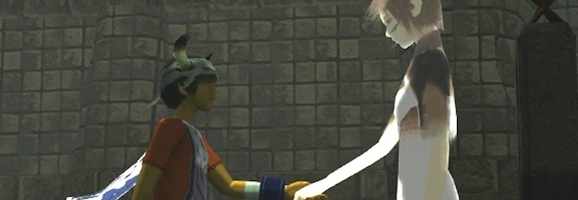
It is only through the use of a companion that Ico’s treatise on loneliness and isolation can be fully realized. Attachment is a product of separation. Loneliness only makes companionship all the more desirable. The game mechanics work to make the player desperately, furiously attached to Yorda.
The most obvious mechanic used is that of hand-holding. Touch is an essential element of attraction in the real world, and Ueda works to incorporate the physicality of touch into the game world. The virtual nature of a videogame makes this challenging, but Ueda bridges the gap between the virtual and physical worlds using the one aspect of videogames that must exist in the real world – the controller. Typically a controller is physically used to effect change in the virtual world. However, in Ico the controller serves a further purpose: to simulate feelings from the game world directly to the player. It does this through use of the rumble feature. When Ico holds Yorda’s hand and drags her through the environment, the controller vibrates in regular, soothing intervals. The attachment is further simulated by the need to hold down the R1 button, a motion that is similar to that used when holding a hand. The control mechanics work to increase the player’s attachment to Yorda by simulating the holding of her hand in a real, physical way.
Ueda goes to a great deal of effort to make the player attached to Yorda, and nowhere is this more obvious than in separation. During the course of normal gameplay, there are numerous occasions where, in order to progress, Ico must go ahead of Yorda, separating the two for short periods of time. The game plays up the anxiety of these moments, putting Yorda in direct danger. Although it is possible to fail by missing a platforming jump and dying, by far the most aggressive threat to the player’s success are mysterious shadow creatures that attempt to wrench Yorda from the player’s grasp and pull her into dark, mystical pits. It is telling that these creatures often appear just as Ico goes ahead, and the camera delights in pulling back to show you, the player, the danger you have left your companion in. Occasionally the only indication of the danger is a short, sharp cry and a foreboding, ethereal scraping sound indicating the presence of these antagonists. It gets to the point where the player fears leaving Yorda behind, a state of separation anxiety that is transposed directly from the expected fear of failure.
Eventually, however, the player is separated from Yorda within the narrative, plunging from the castle’s drawbridge into the caverns below. This final act of the game serves as a standard rescue mission as you return to defeat the evil Queen and rescue Yorda. It is during these moments that the player is empowered and overcomes their separation anxiety, realizing their self-worth. This culminates in the discovery of a sword that provides the same powers that Yorda offered earlier in the game, opening pathways for progression. This is Ico’s – and the player’s – acceptance of their isolated existence. The game’s conclusion confirms this acceptance as necessary – the Queen reveals that Yorda can never leave the castle and, as the structure collapses, Ico is pushed from its shores on a boat alone.
Power in Isolation

There is much more to discuss in relation to Ico, but my purpose was to examine closely how the game’s mechanics offer an experience of loneliness and isolation to the player. A post-credits sequence confirms this as the theme Ueda was most concerned with.
Walking along an empty beach, Ico’s victory is bittersweet. He survived and escaped his captivity, but in actuality he has solved nothing. He is still alone in an antagonistic, vast world.
There is the suggestion of change, of hope. His horns are gone, broken off in his final battle. The ‘curse’ is removed. More importantly, further along the beach he comes across a body. Yorda has somehow, miraculously, reached the mainland. Whether her presence is physical or not is unimportant. She is symbolic of a change within Ico, an acceptance that she is now a part of him. At the end of the game he was using her powers, and now her presence will be with him always.
This experience would be impossible to replicate in any other medium with such clarity and subtlety. Hopefully, as developers examine the power of this interactive medium we will see more games with the emotional and thematic depth of Ico.
What do you think? Leave a comment.




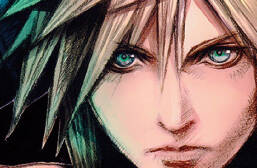
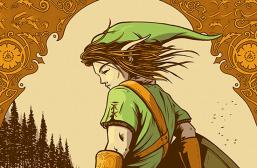


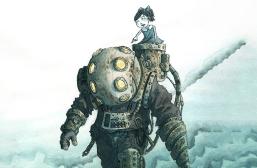


I used to be a dedicated gaming enthusiast years and years ago in the final fantasy 7 PS1 days. Just when I thought in my mid-twenties that I had totally and forever lost any real significant interest in video games, I get laid off from work.Hmmm. I begin pondering how to use some spare time; nothing like a bit of video game playing to pass the time and ease the frustration of job rejections. So I borrowed a friend’s PS2 and rented Ico. I’m not really sure what nudged me in the direction of this game. Maybe it’s the fact that I remember years ago when it first came out how much of an impact it’s lush graphics had on me and I only played a demo version of it at Wal-mart for 15 minutes. I remember thinking to myself one day I got to really check this game out.To say that Ico has restored and quickened my interest after so long is an understatement and an ultimate testimoney to this game’s power.
This is a wonderfully written article and a delight to read! Usually games with ‘escort missions’ can be awfully frustrating, but Team Ico are masters of atmosphere and manipulating emotions, and you’ve covered why Ico is such a brilliant game that will most likely be always held in high-esteem.
Also I’m really happy that you touched on the camera work! I remember noticing it in Shadow of the Colossus as well, and again it excellently highlights the atmosphere of solitude and works so well!
excellent article, nice to see people analyze the meanings of mechanics. You should consider doing one for Shadow of the Colossus, as that’s a game rife with interesting thematic material.
Yes, I was actually leading up to that. I’ll need to give it another play-through before I do so, though.
Fumito Ueda is pretty much unmatched in his ability to get you immersed in his games. It’s too bad he is such a weirdo loser when it comes to depictions of women.
This is a great article and I think you really managed to touch on some of the key factors that make Ico such an unforgettable experience. I’ve only really had a chance to play Shadow of the Colossus in depth, but it shares so many similarities with Ico that I can relate to a lot of what you’ve described. The team’s use of isolation is particularly powerful.
The thing that always brings me back to Ico is the huge, beautiful environments and architecture. I feel like if modern games are getting one thing wrong, it’s the lack of huge architecture to explore freely. Dark Souls does a really nice job of this, though.